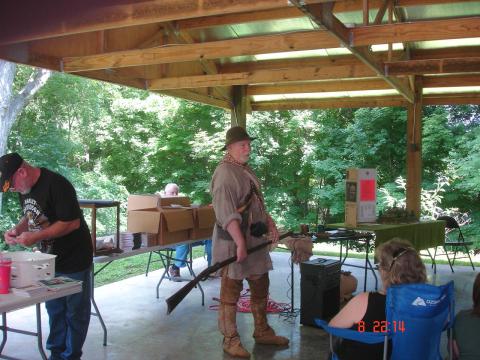Who Were the Longhunters?
Robert Kato, a Longhunter reenactor, speaks at the June 9, 2018 meeting of the Nicholas Gibbs Historical Society.
Groups called Longhunters [18th century explorers and hunters] were the first to blaze the trails into the American wilderness across the United States. Elisha Wolfe led a group of Longhunters as early as 1761-1765. Longhunters didn’t come with the intention of becoming settlers–people drive away animals–but rather the financial adventure of hunting bison. Buffalo once grazed in east Tennessee, Virginia and North Carolina. Both the meat and the hide were valuable products. As I understand it, thirty or forty hunters would come to a fort or station and then break up into groups of two or three. These hunts continued to 1905 by which time the bison had been eradicated.
The salt lakes in middle Tennessee were prime spots to find bison. The Longhunters were the first to sketch maps for us. The typical clothing of the longhunter was linen shirts dyed with walnut hulls. Linen was an inexpensive cloth made from flax. Their pants and moccasins were made from tanned deer hide.
Men did not go out without their hat and neck scarf as was the custom of the day. Each hunter carried a habersack, a hunting pouch and knife, a linen strip and took two or three horses with him. The linen strip was used to tamp the bullet(s) down the rifle barrel. He carried a powder horn, and ball to load his rifle. The loading of the lead was worked down with his knife, then the gun powder was loaded. They carried tools to work on their gun. Most long rifles carried by the Longhunters were 50 caliber to hunt bison. A 36 caliber rifle was suitable for squirrels and rabbits. The flintlock rifle time frame was from about 1809 to 1830. Matches started being made about 1830. Before that flint was rubbed together next to a small wad of fiber or cotton to ignite a fire. The expressions “Lock, stock and barrel” [meant the three parts of a rifle–the whole thing] and “Flash in the pan” [meant the gun powder ignited without a bullet being fired] came from the longhunters. The gun powder consisted of potassium nitrate, sulfate, charcoal and sulphur. About 10 grains of lead measured by a tip from a horn was loaded in a rifle and gun powder measured by another smaller horn tip was used to load the gun powder. Originally a wad or wadding was rammed down on top of the powder charge, then the ball and then more wadding.
At the request of some of the guests, Mr. Kato fired his rifle for us but without the bullets. We owe much to these brave men who made many sacrifices in order to explore our land.
- Log in to post comments
